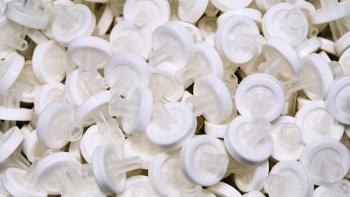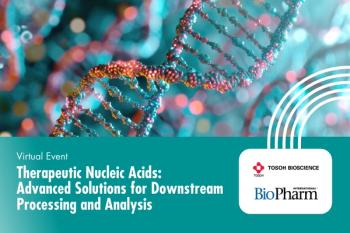
- BioPharm International-03-01-2010
- Volume 23
- Issue 3
Downstream Processing: Promising Technologies are on the Horizon
The new technologies being developed to improve downstream systems go beyond traditional chromatography.
Downstream processing used to be the Rodney Dangerfield of biopharmaceutical manufacturers ... cleaning up crude bulk product got no respect, especially after the relatively glamorous upstream manufacturing from living organisms. Today, that's changing because outdated filtration, chromatography, and purification steps are creating real bottlenecks.1 As a result, both manufacturers and vendors are looking hard at new technologies to improve their downstream systems. This is the first column in a series that will discuss new technologies for downstream processing.
Eric Langer
Most manufacturers agree that the cost and complexity of chromatography steps are the real sticking points, and our current 7th Annual Biomanufacturing Survey data shows that 53% of biopharmaceutical managers feel it's the biggest downstream problem today. Yet, even as internal company pressures to reduce operating costs grow, most managers still concede that major breakthroughs are unlikely in the short term. On the other hand, they also accept that small, incremental improvements are unlikely to dramatically lower overall costs. The technical change that led to the downstream bottlenecks is, of course, the increase in upstream fermentation and cell culture yields. This is unlikely to slow, and the continuous yield improvements for target proteins continue to burden downstream operations.
So, where are we going to find relief? There's an increasing push to move away from traditional Protein A as an affinity chromatography ligand and find solutions that are cost-effective and readily acceptable to regulatory authorities. And even though few companies want to be the first to blaze the regulatory approval trail, many are considering the move. In fact, for new production units, 35% of the industry is considering alternatives to Protein A today.2
WHERE ARE THE IMPROVEMENTS?
At present, few real commercial options exist, but promising technologies are on the horizon or entering commercial production. We do expect to see improvement, including membrane processes, monoclonal-fragment technology, and more specialty resins and synthetic affinity matrices that are priced near Protein A.
It's a matter of time before an alternative to traditional chromatography for antibody purification becomes an industry norm. Eventually, the industry and the FDA will move away from tried-and-true methods of purification, but when that happens, simpler, cheaper, and FDA-approvable alternatives are likely to take hold rapidly.
Our survey data show that most companies are already investigating new technologies. Those not paying attention may get stuck with manufacturing processes for their pipeline products that are simply not competitive.
So it's not surprising that most are not sitting still on the issue. Our current study illustrates the dramatic changes now emerging. Nearly two-thirds (65%) of respondents are increasing their budgets for acquisition of new downstream processing technologies in 2010. This shows that adoption of new purification technologies is a distinct trend. Table 1 includes some of the technologies from our study that biopharmaceutical companies are currently examining.2
Table 1. Downstream technologies that iopharmaceutical companies are currently examining
Even as end-users are investigating broad technologies, specific alternatives to Protein A and traditional purification are becoming commercialized. Some of these are listed below.
- Single-use downstream chromatography: Novozymes's new patented Dual Affinity Polypeptide technology platform replaces Protein A process steps with similar, but disposable, technology
- Stimuli responsive polymers enable complexation and manipulation of proteins and allow for control of polymer and protein complex solubility, which results in the direct capture of the product without centrifuges or Protein A media, from Millipore Corp
- Mixed mode sorbents to replace traditional Protein A and ion exchange, for improved selectivity and capacity with shorter residence times. These media, with novel chemistries, include hydrophobic charge induction chromatography, such as MEP, and Q and S HyperCel from Pall Corp
- Monoliths, involving chromatography medium as a single-piece homogeneous column, such as Convective Interaction Media monolithic columns from BIA Separations
- Simulated moving beds, involving multicolumn countercurrent chromatography, such as BioSMB from Tarpon Biosystems
- Protein G (multiple vendors)
- Single domain camel-derived (camelid) antibodies to IgG, such as CaptureSelect from BAC
- New inorganic ligands, including synthetic dyes, such as Mabsorbent A1P and A2P from Prometic Biosciences
- Expanded bed adsorption chromatography systems, such as the Rhobust platform from Upfront Chromatography
- Ultra-durable zirconia oxide-bound affinity ligand chromatography media from ZirChrom Separations
- Fc-receptor mimetic ligand from Tecnoge
- ADSEPT (ADvanced SEParation Technology) from Nysa Membrane Technologies
- Membrane affinity purification system from PurePharm Technologies
- Custom-designed peptidic ligands for affinity chromatography from Prometic Biosciences, Dyax, and others
- Protein A- and G-coated magnetic beads, such as from Invitrogen/Dynal
- New affinity purification methods based on expression of proteins or MAbs as fusion proteins with removable portion (tag) having affinity for chromatography media, such as His(tidine) tags licensed by Roche (Genentech)
- Protein A alternatives in development, including reverse micelles (liposomes), liquid–liquid extraction systems, crystallization, immobilized metal affinity chromatography, and novel membrane chromatography systems
- Plug-and-play solutions with disposable components (e.g., ReadyToProcess), process development ÄKTA avant with design of experiments capability, and multicolumn continuous capture, from GE Healthcare.
SUMMARY
Those not paying attention to what's happening are likely to miss out on critical opportunities for both near- and long-term process improvements. New purification technologies are being actively pursued by both vendors and end-users. Suppliers, such as Pall Corporation's Global Technical Director Jon Petrone believes, "Downstream purification has the potential to become a critical bottleneck in large-scale monoclonal antibody production as titers continue to increase."
Eric Grund, senior director of Biopharma Applications at GE Healthcare, agrees, "Resolving [downstream purification challenges] with new, cost-effective technologies that will meet safety expectations is a priority ... flexibility is the most desired feature of any downstream processing chain. A manufacturer may have to handle increased demand one day and alternative products the next."
From the end-user's perspective, bioprocessing improvements are becoming a major focus. In fact, last year, over two-thirds of biomanufacturers (67%) reported either "some" or "significant" improvements from changes to their downstream operations.2 This will continue as the industry deals with downstream processing challenges.
Disposable equipment may deliver the greatest shift in how biomanufacturing is done in the future. Today, a majority of manufacturers are reporting the use of at least some single-use equipment in commercial-scale production. So, when fully disposable downstream processes are introduced, there may be relatively rapid adoption and the potential for substantial growth. They may open the way to completely modular, mobile biopharmaceutical operations. The cost, time, and quality improvements derived from single-use components may then extend to separation and chromatography steps. In fact, most large biomanufacturers are now seriously considering integrated disposable alternatives. According to Robert Blanck, bioprocess strategic marketing manager at Millipore Corp., "We are working on new integrated disposable process solutions [that incorporate] bioreactor, chromatography, TFF, virus filtration, sterile filtration, buffer/media storage, and intermediate handling."
More biopharmaceutical products are moving through the pipeline and cost pressures are continuing to mount.3 These competitive pressures are pushing new downstream technologies toward commercial and, ultimately, regulatory acceptance. The next column will cover regulatory aspects and the receptivity of regulators toward adoption of new downstream processing technologies.
Eric Langer is president and managing partner at BioPlan Associates, Inc., Rockville, MD. He is also a member of BioPharm International's editorial advisory board and the editor of Advances in Biopharmaceutical Technology in India, 301.921.5979,
REFERENCES
1. 7th Annual Report and Survey of Biopharmaceutical Manufacturing. 2010 preliminary data. BioPlan Associates, Inc; Rockville, MD. Available from:
2. 6th Annual Report and Survey of Biopharmaceutical Manufacturing, April 2009 online edition. BioPlan Associates, Inc; Rockville, MD. Available from:
3. Rader RA. Biopharma:Biopharmaceutical Products in the US and European Markets. BioPlan Associates; Rockville, MD. Available from:
Articles in this issue
almost 16 years ago
BioPharm International, March 2010 Issue (PDF)almost 16 years ago
India's Future as a Biologics Manufacturing Hubalmost 16 years ago
Corrective and Preventative Action Programs: A Mechanism of Controlalmost 16 years ago
Characterizing the Formulation Design Spacealmost 16 years ago
FDA Seeks More Timely Drug Information Electronicallyalmost 16 years ago
Quality Considerations for Peptide Manufacturing Processesalmost 16 years ago
Lessons from the War on TerrorismNewsletter
Stay at the forefront of biopharmaceutical innovation—subscribe to BioPharm International for expert insights on drug development, manufacturing, compliance, and more.




